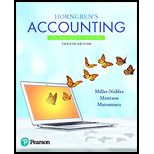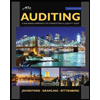
Horngren's Accounting (12th Edition)
12th Edition
ISBN: 9780134486444
Author: Tracie L. Miller-Nobles, Brenda L. Mattison, Ella Mae Matsumura
Publisher: PEARSON
expand_more
expand_more
format_list_bulleted
Textbook Question
Chapter 8, Problem E8.16E
Understanding internal control, components, procedures, and laws
Learning Objectives 1, 2, 3
Match the following terms with their definitions.
| 1. Internal control |
a. Two or more people working together to overcome internal controls. |
| 2. Control procedures |
b. Part of internal control that ensures resources are not wasted. |
| 3. Firewalls |
c. Requires companies to review internal control and take responsibility for the accuracy and completeness of their financial reports. |
| 4. Encryption |
d. Should be prenumbered to prevent theft and inefficiency. |
| 5. Environment |
e. Limits access to a local network. |
| 6. Information system |
f. Example: The person who opens the bank statement should not also be the person who is reconciling cash. |
| 7. Separation of duties |
h. Examination of a company's financial statements and accounting system by a trained accounting professional. |
| 8. Collusion |
g. Identification of uncertainties that may arise due to a company's products, services, or operations. |
| 9. Documents |
i. Without a sufficient one of these, information cannot properly be gathered and summarized. |
| 10. Audits |
j. The organization plan and all the related measures that safeguard assets, encourage employees to follow company policies, promote operational efficiently, and ensure accurate and reliable accounting data. |
| 11. Operational efficiency |
k. Component of internal control that helps ensure business goals are achieved. |
| 12. Risk assessment |
l. Rearranges data by a mathematical process. |
| 13. Sarbanes-Oxley Act |
m. To establish an effective one, a company's CEO and top managers must behave honorably to set a good example for employees. |
Expert Solution & Answer
Learn your wayIncludes step-by-step video

schedule03:13
Students have asked these similar questions
Which is not an objective of internal controls?A. Safeguard assetsB. Improve profitsC. Ensure accurate recordsD. Promote operational efficiencyneed help
Which is not an objective of internal controls?A. Safeguard assetsB. Improve profitsC. Ensure accurate recordsD. Promote operational efficiencyno ai
Can you solve this general accounting problem using appropriate accounting principles?
Chapter 8 Solutions
Horngren's Accounting (12th Edition)
Ch. 8 - Which of the following is not part of the...Ch. 8 - Prob. 2QCCh. 8 - Prob. 3QCCh. 8 - Prob. 4QCCh. 8 - Prob. 5QCCh. 8 - Prob. 6QCCh. 8 - Prob. 7QCCh. 8 - Prob. 8QCCh. 8 - Prob. 9QCCh. 8 - Prob. 10QC
Ch. 8 - Prob. 11QCCh. 8 - Prob. 1RQCh. 8 - Prob. 2RQCh. 8 - What are the five components of internal control?...Ch. 8 - Prob. 4RQCh. 8 - Prob. 5RQCh. 8 - Prob. 6RQCh. 8 - Prob. 7RQCh. 8 - Prob. 8RQCh. 8 - Prob. 9RQCh. 8 - What are the steps taken to ensure control over...Ch. 8 - Prob. 11RQCh. 8 - Prob. 12RQCh. 8 - Prob. 13RQCh. 8 - Prob. 14RQCh. 8 - Prob. 15RQCh. 8 - Prob. 16RQCh. 8 - Prob. 17RQCh. 8 - Prob. 18RQCh. 8 - Prob. S8.1SECh. 8 - Prob. S8.2SECh. 8 - Prob. S8.3SECh. 8 - Prob. S8.4SECh. 8 - Prob. S8.5SECh. 8 - Recording credit card and debit card sales...Ch. 8 - Prob. S8.7SECh. 8 - Prob. S8.8SECh. 8 - Prob. S8.9SECh. 8 - Prob. S8.10SECh. 8 - Prob. S8.11SECh. 8 - Prob. E8.12ECh. 8 - E8-13 Identifying internal controls Learning...Ch. 8 - Prob. E8.14ECh. 8 - Prob. E8.15ECh. 8 - Understanding internal control, components,...Ch. 8 - Prob. E8.17ECh. 8 - Prob. E8.18ECh. 8 - Journalizing credit card sales Learning Objective...Ch. 8 - Prob. E8.20ECh. 8 - Prob. E8.21ECh. 8 - Prob. E8.22ECh. 8 - Prob. P8.23APGACh. 8 - Prob. P8.24APGACh. 8 - Prob. P8.25APGACh. 8 - Prob. P8.26APGACh. 8 - Learning objective 6 Adjusted Balances $18,025 The...Ch. 8 - Prob. P8.28APGACh. 8 - Prob. P8.29BPGBCh. 8 - Prob. P8.30BPGBCh. 8 - Prob. P8.31BPGBCh. 8 - Prob. P8.32BPGBCh. 8 - Prob. P8.33BPGBCh. 8 - Prob. P8.34BPGBCh. 8 - Prob. P8.35CTCh. 8 - Prob. P8.36CPCh. 8 - Prob. P8.37PSCh. 8 - Prob. 8.1TIATCCh. 8 - Prob. 8.1DCCh. 8 - Prob. 8.2DCCh. 8 - Prob. 8.1FCCh. 8 - Prob. 8.1FSC
Additional Business Textbook Solutions
Find more solutions based on key concepts
Quick ratio and current ratio (Learning Objective 7) 1520 min. Consider the following data COMPANY A B C D Cash...
Financial Accounting, Student Value Edition (5th Edition)
The alternative investment that has the lowest volatility on having similar expected return as Company M. Intro...
Corporate Finance (4th Edition) (Pearson Series in Finance) - Standalone book
There is a huge demand in the United States and elsewhere for affordable women’s clothing. Low-cost clothing re...
Operations Management
5. Which inventory costing method results in the lowest net income during a period of rising inventory costs?
W...
Horngren's Financial & Managerial Accounting, The Financial Chapters (Book & Access Card)
Discussion Analysis A13-41 Discussion Questions 1. How do managers use the statement of cash flows? 2. Describ...
Managerial Accounting (5th Edition)
Preference for current ratio and quick ratio. Introduction: Current ratio explains the liquidity position of a ...
Gitman: Principl Manageri Finance_15 (15th Edition) (What's New in Finance)
Knowledge Booster
Learn more about
Need a deep-dive on the concept behind this application? Look no further. Learn more about this topic, accounting and related others by exploring similar questions and additional content below.Similar questions
- Which is not an objective of internal controls?A. Safeguard assetsB. Improve profitsC. Ensure accurate recordsD. Promote operational efficiency no aiarrow_forwardPlease provide the accurate answer to this financial accounting problem using appropriate methods.arrow_forwardI am searching for the accurate solution to this financial accounting problem with the right approach.arrow_forward
- 20 Nelson and Murdock, a law firm, sells $8,000,000 of four-year, 8% bonds priced to yield 6.6%. The bonds are dated January 1, 2026, but due to some regulatory hurdles are not issued until March 1, 2026. Interest is payable on January 1 and July 1 each year. The bonds sell for $8,388,175 plus accrued interest. In mid-June, Nelson and Murdock earns an unusually large fee of $11,000,000 for one of its cases. They use part of the proceeds to buy back the bonds in the open market on July 1, 2026 after the interest payment has been made. Nelson and Murdock pays a total of $8,456,234 to reacquire the bonds and retires them. Required1. The issuance of the bonds—assume that Nelson and Murdock has adopted a policy of crediting interest expense for the accrued interest on the date of sale.2. Payment of interest and related amortization on July 1, 2026.3. Reacquisition and retirement of the bonds.arrow_forward13 Which of the following is correct about the difference between basic earnings per share (EPS) and diluted earnings per share? Question 13 options: Basic EPS uses comprehensive income in its calculation, whereas diluted EPS does not. Basic EPS is not a required disclosure, whereas diluted EPS is required disclosure. Basic EPS uses total common shares outstanding, whereas diluted EPS uses the weighted-average number of common shares. Basic EPS is not adjusted for the potential dilutive effects of complex financial structures, whereas diluted EPS is adjusted.arrow_forwardPlease explain the solution to this general accounting problem with accurate explanations.arrow_forward
- I need guidance with this financial accounting problem using the right financial principles.arrow_forwardGeneral Accounting Question Solutionarrow_forwardWhich is not an objective of internal controls?A. Safeguard assetsB. Improve profitsC. Ensure accurate recordsD. Promote operational efficiencyarrow_forward
arrow_back_ios
SEE MORE QUESTIONS
arrow_forward_ios
Recommended textbooks for you
 Auditing: A Risk Based-Approach to Conducting a Q...AccountingISBN:9781305080577Author:Karla M Johnstone, Audrey A. Gramling, Larry E. RittenbergPublisher:South-Western College PubPrinciples of Accounting Volume 1AccountingISBN:9781947172685Author:OpenStaxPublisher:OpenStax CollegePrinciples of Accounting Volume 2AccountingISBN:9781947172609Author:OpenStaxPublisher:OpenStax College
Auditing: A Risk Based-Approach to Conducting a Q...AccountingISBN:9781305080577Author:Karla M Johnstone, Audrey A. Gramling, Larry E. RittenbergPublisher:South-Western College PubPrinciples of Accounting Volume 1AccountingISBN:9781947172685Author:OpenStaxPublisher:OpenStax CollegePrinciples of Accounting Volume 2AccountingISBN:9781947172609Author:OpenStaxPublisher:OpenStax College Accounting Information SystemsAccountingISBN:9781337619202Author:Hall, James A.Publisher:Cengage Learning,
Accounting Information SystemsAccountingISBN:9781337619202Author:Hall, James A.Publisher:Cengage Learning, Auditing: A Risk Based-Approach (MindTap Course L...AccountingISBN:9781337619455Author:Karla M Johnstone, Audrey A. Gramling, Larry E. RittenbergPublisher:Cengage Learning
Auditing: A Risk Based-Approach (MindTap Course L...AccountingISBN:9781337619455Author:Karla M Johnstone, Audrey A. Gramling, Larry E. RittenbergPublisher:Cengage Learning

Auditing: A Risk Based-Approach to Conducting a Q...
Accounting
ISBN:9781305080577
Author:Karla M Johnstone, Audrey A. Gramling, Larry E. Rittenberg
Publisher:South-Western College Pub

Principles of Accounting Volume 1
Accounting
ISBN:9781947172685
Author:OpenStax
Publisher:OpenStax College

Principles of Accounting Volume 2
Accounting
ISBN:9781947172609
Author:OpenStax
Publisher:OpenStax College

Accounting Information Systems
Accounting
ISBN:9781337619202
Author:Hall, James A.
Publisher:Cengage Learning,

Auditing: A Risk Based-Approach (MindTap Course L...
Accounting
ISBN:9781337619455
Author:Karla M Johnstone, Audrey A. Gramling, Larry E. Rittenberg
Publisher:Cengage Learning

Internal Control Components; Author: Accounting Instruction, Help, & How To;https://www.youtube.com/watch?v=D8SSaqpE6L8;License: Standard Youtube License